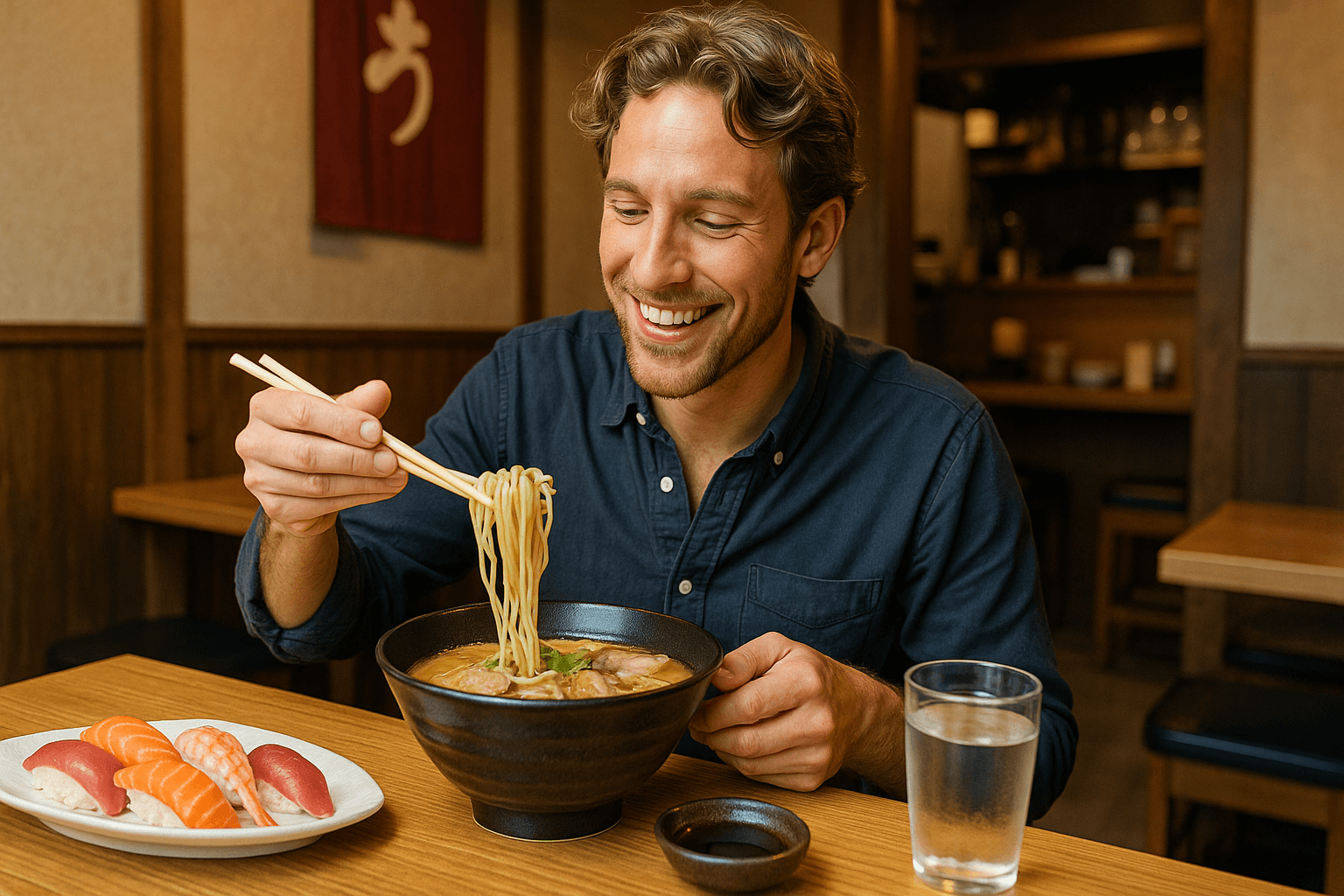Japan isn’t just a country—it’s a culinary wonderland. From the smoky aroma of ramen broth simmering in a hidden alleyway to the elegance of sushi served by master chefs, every bite tells a story of tradition, innovation, and obsession with detail. For food lovers, Japan is nothing short of paradise.
This Japan food guide is your ticket to navigating ramen shops, sushi counters, izakayas, and regional specialties that define Japanese cuisine. Whether you’re a first-time visitor or a returning traveler hungry for new experiences, here’s everything you need to eat like a local—and love every moment of it.
Why Japan is a Food Paradise
Japan’s food culture is built on respect—for ingredients, for seasons, and for the act of dining itself. Meals are not rushed; they’re experiences, whether you’re grabbing quick noodles from a vending machine ramen joint or indulging in a multi-course kaiseki dinner.
Here’s why Japan is foodie heaven:
- Variety: From street snacks to Michelin-starred dining, there’s something for every budget.
- Quality: Even convenience store meals are fresh, tasty, and surprisingly gourmet.
- Regional diversity: Each prefecture has unique specialties that reflect its climate and culture.
- Innovation: Chefs continuously reinvent classics while respecting tradition.
Hungry yet? Let’s dive into the ultimate Japan food guide.
Best Ramen Shops in Tokyo, Osaka, and Fukuoka
Ramen is more than noodles—it’s a national obsession. Every city has its own style, and sampling regional variations is a foodie adventure in itself.
Tokyo: Soy-Based and Shoyu Ramen Heaven
- Ichiran Shinjuku: Famous worldwide for its solo dining booths and customizable tonkotsu ramen. A must for first-timers.
- Afuri (Harajuku): Known for its light, refreshing yuzu shio ramen, perfect for those who prefer a citrusy twist.
- Rokurinsha (Tokyo Station Ramen Street): Home of tsukemen (dipping noodles) with thick, rich broth.
Osaka: Bold Flavors and Street Vibes
- Hanamaruken (Namba): Their “Happiness Ramen” features melt-in-your-mouth pork ribs.
- Kinryu Ramen (Dotonbori): Iconic dragon signage, open 24 hours—perfect for late-night cravings.
- Menyabushido: A local favorite serving hearty, flavorful bowls that reflect Osaka’s love of bold taste.
Fukuoka: Tonkotsu Ramen Capital
- Ichiran (Nakasu): While now global, this is the birthplace of the chain—authentic tonkotsu at its finest.
- Hakata Issou: Rich, creamy broth with noodles so thin they practically melt.
- Yatai Stalls: Don’t miss the riverside food stalls offering steaming bowls of Hakata ramen alongside yakitori and beer.
💡 Pro Tip: In Japan, it’s polite (and encouraged) to slurp your noodles—it cools them down and shows appreciation.
Sushi Experiences: From Conveyor Belts to Omakase
No Japan food guide is complete without sushi. It’s a cuisine that ranges from quick and fun to refined and ceremonial.
Conveyor Belt Sushi (Kaiten-zushi)
Affordable and entertaining, conveyor belt sushi is perfect for casual dining. Plates are color-coded by price, and you simply grab what you want.
- Sushiro: One of Japan’s most popular kaiten chains, with fresh fish and seasonal specials.
- Genki Sushi (Shibuya, Tokyo): High-tech ordering and delivery via mini shinkansen trains.
- Kura Sushi: Known for playful touches like capsule toy rewards after finishing plates.
Omakase: Trust the Chef
Omakase (literally “leave it to the chef”) is the pinnacle of sushi dining. Expect perfectly balanced nigiri prepared right in front of you.
- Sukiyabashi Jiro (Tokyo): World-famous thanks to the documentary Jiro Dreams of Sushi. Bookings are nearly impossible, but it’s legendary.
- Sushi Saito (Tokyo): Michelin-starred and renowned for its intimacy and perfection.
- Local gems: Smaller omakase counters in Kyoto, Kanazawa, and Sapporo often provide equally exquisite experiences without global fame.
Budget-Friendly Sushi
Even on a budget, sushi in Japan is top-notch.
- Uogashi Nihon-Ichi (Tokyo): Standing sushi bars with fresh, quick bites.
- Supermarkets: Evening discounts make take-home sushi a surprisingly good deal.
- Conveyor belt chains: As above, always fresh and accessible.
Izakaya Culture Explained
If ramen fills your belly and sushi delights your taste buds, izakayas feed your soul. An izakaya is a Japanese pub where food and drink flow together in a lively, communal atmosphere.
What to Expect
- Atmosphere: Casual, noisy, and full of laughter. Think of it as Japan’s answer to tapas bars.
- Seating: Options include counter seating, tables, or tatami mats in private rooms.
- Ordering: Plates are small and meant for sharing. Common dishes include yakitori, karaage (fried chicken), sashimi, and grilled fish.
- Drinks: Beer, sake, shochu, and highballs are staples.
Famous Izakaya Areas
- Shinjuku Omoide Yokocho (Tokyo): Tiny alleys filled with smoke, skewers, and history.
- Ebisu Yokocho (Tokyo): A vibrant cluster of izakayas perfect for bar-hopping.
- Hozenji Yokocho (Osaka): Stone-paved alleys that combine old-world charm with Osaka’s food-loving energy.
💡 Tip: Expect a small otoshi (appetizer charge) with your first drink—it’s part of the izakaya culture.
Must-Try Regional Foods Across Japan
Japanese cuisine is deeply regional, and traveling across the country means tasting the flavors that define each prefecture. Here are highlights no foodie should miss.
Hokkaido
- Soup Curry (Sapporo): Spicy, hearty curry soup packed with vegetables and meat.
- Hokkaido Seafood: Uni (sea urchin), crab, and salmon roe are must-tries at Sapporo’s Nijo Market.
- Jingisukan: Grilled mutton named after Genghis Khan, cooked on dome-shaped grills.
Tohoku
- Kiritanpo (Akita): Grilled rice skewers, often served in hot pot.
- Gyutan (Sendai): Charcoal-grilled beef tongue, tender and savory.
Tokyo & Kanto
- Monjayaki: Similar to okonomiyaki but runnier—best experienced in Tsukishima.
- Unagi (Kawagoe): Freshwater eel grilled and glazed with sweet soy sauce.
Kansai (Osaka & Kyoto)
- Okonomiyaki (Osaka): Savory pancake layered with cabbage, pork, or seafood.
- Takoyaki (Osaka): Octopus balls with sauce, mayo, and bonito flakes.
- Kaiseki (Kyoto): Multi-course haute cuisine that reflects the seasons.
Chugoku & Shikoku
- Hiroshima-style Okonomiyaki: Layered with noodles and cabbage, different from Osaka’s version.
- Sanuki Udon (Kagawa): Chewy wheat noodles, famous for their texture and simplicity.
Kyushu
- Hakata Ramen (Fukuoka): Rich tonkotsu broth with thin noodles.
- Mentaiko: Spicy cod roe, served with rice or pasta.
- Shochu: Distilled spirit, especially popular in Kagoshima.
Okinawa
- Goya Champuru: Stir-fry with bitter melon, tofu, and pork.
- Okinawa Soba: Thick wheat noodles in pork broth.
- Awamori: Local distilled spirit unique to the islands.
Conclusion
Japan is a culinary journey waiting to happen. From steaming bowls of Hakata ramen to conveyor belt sushi, from noisy izakayas to refined kaiseki, the country offers experiences for every palate and budget.
This Japan food guide has taken you through the essentials: ramen hotspots in Tokyo, Osaka, and Fukuoka; sushi adventures from kaiten to omakase; izakaya culture; and regional delicacies that make each part of Japan unique.
Food isn’t just fuel in Japan—it’s a way to connect with history, culture, and people. So, come hungry, travel wide, and let Japan feed not only your stomach but also your soul.

